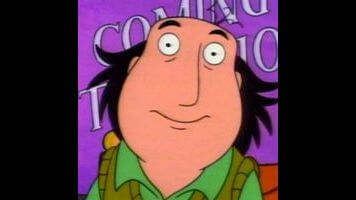The Critic: Miserable”

"Miserable" (season #1; originally aired February 16, 1994)
If the creators of The Critic had had their way, “Miserable” would have aired immediately after the show’s pilot. That meant that The Critic would feature back-to-back episodes in which its ostensibly hapless, luckless protagonist is aggressively pursued by beautiful women seeking a sexual relationship with him.
ABC wasn’t having it. According to the episode’s audio commentary, the network was so shocked and horrified by what it saw as the episode’s pervasive smuttiness that it wanted to nix it altogether. ABC apparently felt the episode was so filthy nothing could redeem it. It consequently fell upon Executive Producer James L. Brooks to save the episode using the incredible power he accrued as one of the most successful and powerful men in Hollywood and one of the driving forces behind The Simpsons, Taxi and The Mary Tyler Moore Show.
Brooks succeeded in getting the episode made but it ended up running fourth rather than second. “Miserable” is relatively tame by today’s standards but it nevertheless features the show’s least commercial elements in unusually pure form. First and foremost there is the episode’s persistent smuttiness. “Miserable” is a tale of ribaldry both in its broad outlines and in its particulars.
The episode’s central plot has Jay entering into an enthusiastic, no-strings-attached sexual relationship with a spooky-eyed projectionist who is eager to fuck his brains out yet is curiously reticent to even introduce herself to him. That’s smutty enough in itself but it’s nothing compared to Jay’s counter-productive defense of American Puritanism.
When Australian best friend Jeremy Hawke disparages American attitudes towards sex, Jay replies, ““We Americans aren’t like you Australians. It’s not just about sex. We want to make love to our mothers” with the perfect note of misplaced self-righteousness. Factor in an extended Indecent Exposure parody featuring a now destitute but still randy Robert Redford and a fantasy sequence where Jay sexualizes the Statue of Liberty and it’s easy to see why ABC viewed “Miserable” as a terrible way to ingratiate the show with skeptical audiences.
“Miserable” doesn’t just nakedly aspire to the New Yorker demographic with jokes about Haing S. Ngor and the salacious titles of Pauline Kael compilations; it actually features a cameo from The New Yorker mascot. Yes, The Critic was not shy about striking the occasional elitist note. That may have doomed them in the long and short run but it ultimately proved central to the show’s genial, cerebral charm.
“Miserable” opens with Jay’s perpetually glowering ex-wife glaring at him from a billboard she had installed outside his window and seemingly everyone in New York in love. The Critic alternates between a jaded, cynical take on New York as the exclusive domain of cranks, assholes and the proudly belligerent and a swooningly romantic view of New York as a glamorous wonderland of art and culture that’s deeply indebted to the films of Woody Allen, particularly Manhattan.
Both strains are apparent in this clip: we open with the familiar take on New Yorkers as belligerent blowhards spoiling for a fight but at the very first provocation these battling New Yorkers transform instantly into lovebirds. Not even cab drivers are immune to the spirit of romance sweeping the city.



















![HBO teases new Euphoria, Larry David, and much more in 2026 sizzle reel [Updated]](https://img.pastemagazine.com/wp-content/avuploads/2025/12/12100344/MixCollage-12-Dec-2025-09-56-AM-9137.jpg)




















